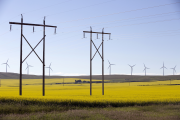Oh, what a difference a week can make.
Just last Monday (January 18) we were busy releasing a report on the hidden environmental impacts of the proposed Enbridge Northern Gateway Pipeline.
The pipeline is designed to carry bitumen from Alberta's oilsands to the B.C. coast; its construction would enable an expansion in oilsands production, which would result in significant new environmental impacts "upstream" from the pipeline. We called on the government to include these upstream impacts in the project's environmental assessment.
 The next day, the National Energy Board was quoted in a Globe and Mail article saying it may broaden the scope of the environmental assessment if it encounters significant concerns about the upstream impacts.
The next day, the National Energy Board was quoted in a Globe and Mail article saying it may broaden the scope of the environmental assessment if it encounters significant concerns about the upstream impacts.
"Just because it wasn't listed in the terms of reference doesn't mean it's not an issue that the hearing can consider," said NEB spokeswoman Kristen Higgens.
That's true, but because the upstream impacts weren't included in the terms of reference, the panel isn't required to consider them.
Not wanting to leave any room for ambiguity, on Friday (January 22) we wrote a letter to Environment Minister Jim Prentice and to Peter Sylvester, president of the Canadian Environmental Assessment Agency, to request the agency revise the final terms of reference to expressly include the upstream issues.
Now we wait. In the meantime, other environmental groups and stakeholders are preparing their own letters to urge the government to amend the terms of reference for the review.
More than 1,000 public comments were received on the draft terms of reference for the joint review panel, more than for any other project in the history of the Canadian Environmental Assessment Agency. We believe this response is a strong indication of substantial public concern.
 In case there remains any question of "significant concern" regarding the upstream impacts of the Enbridge pipeline, here are some highlights from our report:
In case there remains any question of "significant concern" regarding the upstream impacts of the Enbridge pipeline, here are some highlights from our report:
- The new pipeline would result in a 30 percent increase in average daily oilsands output.
- The increased production related to the Enbridge pipeline would produce 6.5 million tonnes of greenhouse gas emissions each year, equivalent to putting another 1.6 million cars on the road.
Each year, the increased oilsands development would
- disturb an area nearly three times the size of Vancouver's Stanley Park.
- use the amount of water consumed annually by a city of 250,000
- produce enough toxic tailings to fill BC Place Stadium 1.5 times
- result in enough tailings leakage to fill 182 Olympic-sized swimming pools.
Until policies are in place to fully address the environmental issues associated with oilsands development, the Pembina Institute recommends no further steps be taken to develop the Enbridge pipeline.
Download the fact sheet outlining the key impacts.
Download the full report, Opening the Door for Oilsands Expansion: The Hidden Environmental Impacts of the Enbridge Gateway Pipeline.








